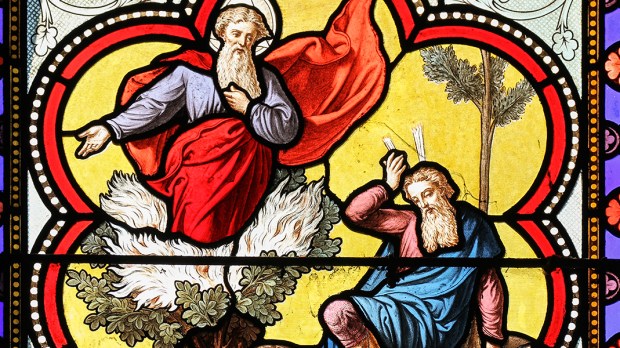O Adonai, et Dux domus Israel,
qui Moysi in igne flammae rubi apparuisti,
et ei in Sina legem dedisti:
veni ad redimendum nos in brachio extento.O Adonai, and leader of the House of Israel,
who appeared to Moses in the fire of the burning bush
and gave him the law on Sinai:
Come and redeem us with an outstretched arm.
“Adonai” simply means “Lord” in Hebrew, and in the Old Testament this word can be found some 450 times. The second O Antiphon, in its four short lines, is a sweeping review of salvation history. The first line reminds us that the Israelites are the chosen people led by God himself as Creator and Sustainer. The reference to Moses and the burning bush in the second line calls to mind the whole story of the Israelites’ captivity in and exodus from Egypt. The law, or the Ten Commandments, draws us into proper relationship with the living God and with one another. And, finally, redemption by means of outstretched arms naturally turns our minds to the cross.
Today, the Church and her faithful call out for their Lord, their “Adonai.” Advent is, of course, a time of expectation. But it is also a penitential season. This is why the liturgical color is purple. And this chant reminds us of this reality: we are sinners. We have offended our God, and because of this, we are in need of a savior. We wait with penitential expectation knowing that our Adonai will come, pure and undefiled, as a tiny baby born of a Virgin.
Let us recall the prophecy of Isaiah here: “The Lord is our judge, the Lord is our ruler, the Lord is our king; he will save us” (Is. 33:22). Scripture abounds with this notion of penance and hopeful expectation. We see it in the prophets and we see it in the psalms. Sorrow for our sins, but every confidence in God’s mercy. St. Leo the Great preached about this anticipated Savior on Christmas Day in 452:
In one and the same Conception, one and the same Birth, our Lord Jesus Christ was brought forth. In him were both true divinity (for working miracles) and true humanity (for enduring sufferings).
It is this Lord whom the star heralded. It is this Lord whom the shepherds rushed to see. It is this Lord whom the Magi traveled to pay homage and bring gifts. This Christ-child lying in the manger is indeed the Savior of whom St. Paul writes: “At the name of Jesus every knee should bow, in heaven and on earth and under the earth, and every tongue confess that Jesus Christ is Lord, to the glory of God the Father” (Phil. 2:10-11).
Our faith is nothing else than faith in the person of Jesus Christ, our Lord and Adonai. This union of God and man, as St. Leo describes, is nothing short of a mystery, but a mystery that is ours to behold. And, like the prophet Isaiah and the saints before us, we too cry out for our Lord to come, clinging to him in faith and hope, awaiting our salvation. Come and redeem us, O Adonai!

